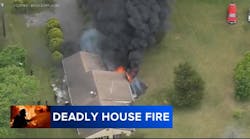After I arrived too late to take a train home from a recent late-night flight into Dallas Fort Worth International Airport, I ordered an Uber. The driver, George, was very engaging from the moment that he popped out of the car and put my bags in the trunk. The ride ended up about 45 minutes because of traffic, but the conversation struck a chord, given some similarities with the fire service.
Most drivers engage very little on the ride. They focus on the traffic and maps or eye up their next customer on the app. I rarely Uber home, but when I do, it’s late at night, so I always just assume that drivers are tired at that point, so I’m used to a quiet ride home.
George said that he’ll size up the situation when he arrives: what’s going on, who is where and people’s movements. He said one of the challenges is that he’s like an ambulance that’s posted to move around a community. He doesn’t have a small response area, so it always is somewhere or someone new.
George said that he communicated with few customers initially during his 10-hour day behind the wheel. He added that it seems to him that communication is a challenge for everybody. He painted the picture of a person getting into the car in a bubble of sorts.
Much like the arrival of an Uber to handle a transportation need or a delivery, firefighters are called out when people need a solution to their situation. Of course, those problems vary greatly, from life-saving actions that require immediacy to replacing a smoke alarm battery at 4 a.m. With Uber, your request to go from point A to point B results in a stranger showing up in a personal vehicle to accomplish the mission.
George enjoys making the experience positive for his customers by doing little things. Often, his customers—just like those who fire departments respond to—are strangers. His first interaction with them likely is his only interaction with them. Despite that, George said, he likes to go the extra mile to ensure that the passenger has a positive experience—not only with him, who is one small part in the Uber business, but with Uber as an international company. His actions, he said, represent thousands of drivers who drive as a full-time job or part-time to pay off some unexpected bills or make extra scratch.
George said that he believes that the little things, such as asking customers about their day or about their upcoming plans or offering them a bottle of water or a charger for their cellphone, often change the customers’ mood after what could have been a problematic or tiresome flight. He engages them during the ride to their destination to create a positive experience but also, he said, because many people do want to talk, particularly those who desire to unwind at the end of the day or to speak about something that’s bothering them that they confronted the previous day.
That’s like something that my father told me years ago about EMS calls to which he responded with the fire departments that he served in. My father wasn’t an EMT, but he told me that he played an important role on those calls, because, with stress levels high, patients’ families needed reassurance or to voice their concerns and fears about an injured loved one. He opened his ears while the crews tended to the patients. He offered the compassion that was needed for the bystanders, which often is overlooked when patient care is the sole focus. My father always said that it was those little things that helped grieving family members in perhaps the worst moments of their life.
Ironically, some departments across the country are shifting to Uber vehicles to get noncritical patients to the hospital, to keep the life-saving equipment in service in their community.
As George dropped me off in downtown Fort Worth, he said the two best pieces of advice that he could pass along to me were “be nice and be courteous.” I wondered whether it was possible that he read some of the works from the late fire chief Alan Brunacini, who introduced the simple theme of “be nice” as a mantra for the fire service, your colleagues and the customers in his teachings about customer service.






